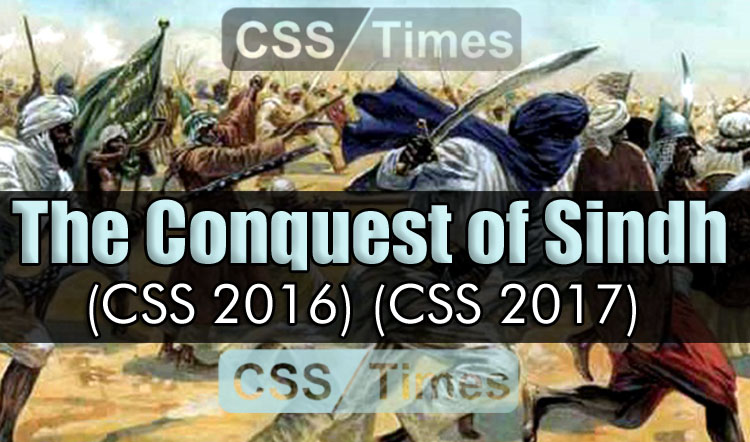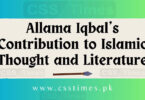The Conquest of Sindh (CSS 2016-2017 & CSS Paper Solved)
The conquest of Sindh, located in today’s Pakistan, happened in stages. During the Caliphate of Omar ibn al Khattab, Muslim armies approached the coast of Makran, but Omar withdrew the troops in response to reports of a harsh and inhospitable terrain. Emir Muawiya subdued eastern Afghanistan and the Northwest Frontier areas. However, it was not until the reign of Walid I (705-713) that much of what is today Pakistan was brought under Muslim rule.
From pre-Islamic times, there was a brisk trade between the eastern coast of the Arabian Peninsula and the western coast of India and Sri Lanka. Ships rode the eastern monsoons to the coast of Malabar and Sri Lanka to pick up spices and returned home riding on the western monsoons. Spices were in great demand throughout West Asia, North Africa and southern Europe and transactions were extremely profitable. This trade continued to thrive and expand with the advent of Muslim rule in West Asia and North Africa. It was through these merchants that Islam was first introduced into Kerala in southwestern India and Sri Lanka, located near the tip of India.
Sindh was notorious for its pirates in those times. These pirates would wait in ambush for merchant ships on the coast of Sindh and would raid them for booty. In the fateful year 707, these pirates attacked one of the Muslim merchant ships sailing back from Sri Lanka to the Persian Gulf. The men, women and children on board the ship were captured and taken inland to Sindh, where the Raja imprisoned them.
Check also: Why Khalistan Movement is Relevant Today
Hajjaj bin Yusuf Saqafi was the Omayyad governor of Iraq. When reports reached him of this incident, he wrote to Raja Dahir demanding that the captives be released and the responsible pirates punished. Dahir refused. This refusal set the stage for the onset of hostilities. It was the responsibility of the Caliphate to protect its citizens and to fight against injustice no matter what quarter it came from. Hajjaj bin Yusuf had that responsibility as a governor representing the Caliph. He sent an expedition under Ubaidullah bin Binhan to free the captives but Ubaidullah was defeated and killed in combat by troops of the Raja.
Determined that the provocations meet an appropriate response, Hajjaj dispatched an army of 7,000 seasoned cavalrymen under Muhammed bin Qasim Saqafi. Muhammed bin Qasim was only a young man of seventeen but was one of the most capable generals of the era. Paying attention to detailed planning, he sent heavy assault engines and army supplies by sea while the cavalry advanced by land through Baluchistan.
The success of an assault requires that the offensive weapons be superior to the defensive weapons. By the year 700, the Muslims had improved upon the various engines of war they had encountered in their advance through Persia, Byzantium and Central Asia. One specific assault engine was the minjanique, a catapult that could throw large stones at enemy forces and fortifications. The catapult, as a weapon of war, was in use in China as early as the 4th century. Muslim engineers made two specific improvements on the Chinese design. First, they added a counterweight to one end of the cantilever, so as to harness the potential energy of the counterweight as the catapult was let go. Second, they mounted the entire mechanism on wheels so that the lateral reaction of the throw did not reduce the range of the machine. The minjaniques could project rounded stones weighing more than two hundred pounds over distances greater than three hundred yards. Persistent pounding by such large stones could bring down the sturdiest walls in the forts in existence at that time.
After capturing Panjgore and Armabel, Muhammed bin Qasim advanced towards the port of Debal, which was located near the modern city of Karachi. The Raja of Debal closed the city gates and a long siege ensued. Once again, the means for offensive warfare proved to be more powerful than the means for defense, enabling the Arab armies to continue their global advance towards military and political centralization. As was the pattern with Arab conquests, theminjaniques threw heavy projectiles at the fort and demolished its walls. After a month, Debal fell. The local governor fled and the Muslim prisoners who had been held there were freed.
Check also Pakistan Affairs MCQs for CSS

From Debal, Muhammed bin Qasim continued his advance to the north and east. All of Baluchistan and Sindh fell including Sistan, Bahraj, Kutch, Arore, Kairej and Jior. Raja Dahir was killed in the Battle of Jior. One of his sons, Jai Singh resisted Muhammed bin Qasim at the Battle of Brahnabad, but he too was defeated and had to flee. Muhammed bin Qasim founded a new city near the present city of Karachi, built a mosque there and advanced northwards to western Punjab. Multan was his target. Gour Singh was the Raja of Multan. His large army was reinforced by contingents from neighboring rajas. The Indians excelled in static warfare with armored elephants and foot soldiers but these were no match against swift, hard hitting cavalry. Realizing the advantage enjoyed by Muhammed bin Qasim’s cavalry in mobile warfare, the Raja locked himself in the fort of Multan. A siege ensued. Once again, the technology of minjaniques proved decisive. The heavy machines destroyed the fort and the raja surrendered. Multan was added to the Arab empire in the year 713.
The conquest of Sindh brought Islamic civilization face to face with the ancient Vedic civilization of the Indo-Gangetic Plains. In later centuries, there was much that Muslim scholarship would learn from India—mathematics, astronomy, iron smelting-to name but a few subjects. (Muslim scholarship has focused more on the interaction between Islam and the West and has neglected the interaction between Islamic civilization and the East. This is a surprise considering that until the 18th century, there was little that the West had to offer the more advanced Islamic civilization. The flow of knowledge was almost always from Islam to the West. By contrast, the Muslims learned a great deal from India).
Soon, the borders of the Omayyad Empire extended to the borders of China and the Muslims acquired a great many advanced technologies from the Chinese, including the processing and manufacture of silk, porcelain, paper and gunpowder. The Prophet himself said: “Seek knowledge even onto China”. The addition of what is today Pakistan consolidated an empire extending from the Pyrenees to the Indus and the Gobi Desert. This vast empire was now rubbing elbows with the ancient civilizations of India and China. From this vantage point, the Muslims were in a superb position to absorb, transform and develop knowledge from Persia, Greece, India and China.
Muhammed bin Qasim was eager to continue his advance into northern and eastern Punjab but events in far away Damascus overtook events in Pakistan. Caliph Walid I died in 713. In the ensuing political turbulence, Muhammed bin Qasim was summoned back to Iraq, just as Musa bin Nusair was summoned from Spain at about the same time.
After the death of Caliph Walid I, the end of Muhammed bin Qasim was even more tragic than that of Musa bin Nusair. Muhammed bin Qasim was a nephew of Hajjaj bin Yusuf, also known as Hajjaj the Cruel, the governor of Iraq. The new Caliph Sulaiman had a personal dislike of Hajjaj but Hajjaj died before Sulaiman could punish him. So, Sulaiman turned instead against Hajjaj’s relatives. Muhammed bin Qasim was dismissed and sent back to Iraq. The new governor of Iraq, Saleh bin Abdur Rahman hated Hajjaj because the latter had killed Saleh’s brother. But since Hajjaj had died, Saleh also turned against Hajjaj’s relatives. Muhammed bin Qasim was arrested and sent to prison for no fault but that he was a nephew of Hajjaj. In prison, Muhammed bin Qasim was blinded, tortured and killed. Thus, ended the life of two of the most brilliant generals of the 8th century.
The fate of Musa bin Nusair and Muhammed bin Qasim is a lesson of historical importance. With the ascension of Muawiya, legitimacy of rule was no longer by consent of the masses; it was by force. Sultan after sultan arose and established himself by dictate or by virtue of inheritance from soldier-conquerors. When a ruler was competent and just, as happened with Omar bin Abdul Aziz, the common people enjoyed some freedoms. When he was a tyrant, as happened with Sulaiman bin Abdul Malik, the people suffered. Since the period of the first fourCaliphs, Muslims have not shown an institutional capability to evolve and nourish their political leadership from among the masses. When the body politic throws up its first echelon of leadership, the tendency has been to destroy that leadership, unless the leader survives through shrewd maneuvering or ruthless imposition. This inability to cultivate and nourish political leadership from the bottom up has defined the limits of Muslim power and in a broader sense, the achievements of Islamic civilization. The survival of potential leaders has always depended on the whims of the despot at the top or of his local political cronies.
A second lesson from the tragic deaths of these two outstanding generals is that the internal dialectic of the world of Islam has defined the limits of its reach. Having completed the conquest of Spain, Musa bin Zubair was ready to launch an invasion of France when he was called back. He might well have succeeded in this goal because there was as yet no strong leader into resist a determined assault. By the time the Muslims did come around to venture into central France, Gaul had a strong leader in Charles Martel and the Muslims were forced to turn around at the Battle of Tours (737). Similarly, Muhammed bin Qasim had successfully penetrated the Indian defenses in the IndusRiver basin. Given a green signal from Damascus and Kufa, he might well have extended the dominions of the Caliphate into the Gangetic plains. This was not to be. Mohammed bin Qasim was called back from Multan just as he prepared to launch a major thrust beyond the Indus River. Northern India remained in Rajput hands for the time being. It was not until the victory of Mohammed Ghori at the Battle of Panipat (1191) that the Muslims captured Delhi. In both cases, it was the internal turmoil in the Muslim body politic that was the determining factor in the arrest of the Muslim advance.
Ultimate Consequences of Arab Conquest of Sindh:
Arab conquest of Sindh was of great significance and impact, politically, socio-culturally, religiously, intellectually and even economically. Though the Arabs were not the actual conquerors of India, they were the path finders and torch bearers. The conquest was a great give and take. Historians attach little importance to Arab rule in Sindh, but though the visible traces of Arab ascendancy have been obliterated, its invisible effects were many and far-reaching. Most of them, of course, relate to the province of Sindh, which has been called “the Hijaz of the Indo-Pakistan sub-continent”.
Effects of the Conquest of Sindh:
Stanley Lane Poole, “the Arab conquest of Sindh is an episode in the history of India and of Islam, a triumph without result”.
Professor Syed Abdu Qadir Shuja-ud-Din, “After the conquest of Sindh a large number of scholars, traders inhabited in Sind. Local people embraced Islam. Today Sindh is the same Islamic region like the Iraq and Egypt, in these circumstances we cannot deny the greatness of the Arab conquest of Sindh, its historical importance and its consequences”.
M.Kabir, “undoubtedly establishment of Islamic government in Sindh is the greatest event in the history of Islam and sub-continent”.
1. Little Effect in Political Sphere:
There is no doubt that Arab conquest was confined to Sindh and Multan only and the major portion of northern India was not directly affected. Expeditions were send against Hindu princes of the north, but the Rajputs were too strong to be defeated. The sudden death of Muhammad bin Qasim and fruitless help of the Khalifah had greatly shaken the Arab stability in Sindh. Within the decline of the power of the Khalifah, territories of Sindh were divided into independent states.
(a) Bin Qasim’s attack revealed the political and military weakness of sub-continent:
The Indo-Pakistan sub-continent presented a chequered picture of warring dynasties and of small kingdoms hostile to one another on the eve of the Arab invasion. There was no central government in the country. All these states enjoyed complete independence and sovereignty. The same situation was on the occasion of the invasion of Alexander the Great. Throughout the history of the sub-continent they united on few occasions otherwise they were fighting for the supremacy on one another.
It was proved from the Muhammad bin Qasim’s invasion that people of sub-continent could not unite from against their common enemy. If they are managed to form a confederation against a common enemy, then they also cannot get their goals. Because in their army there is lack of uniformity and discipline. They belong to different areas and princes thus could not fight bravely and secondly their main problem was lack of leadership. Thus, the attack on Sind revealed their political and military weakness which were helpful for the establishment of Muslim Empire in the sub-continent in the later periods.
The arrangements made by Muhammad bin Qasim with the non-Muslims provided the basis for later Muslim policy in the sub-continent.
(b) Arab soldiers settled:
Most of Arab soldiers settled in Sindh for good and some of them married Sindi women. The Arab and Hindus lived side by side in peace and amity for a long time. The Arabs left a legacy behind in the shape of buildings or administrative or cultural institutions that might have exerted influence on India.
(c) Legacy of Arab Administration:
The Arabs were not only great warriors and conquerors, but also good administrators. The administration introduced by Muhammad bin Qasim in Sindh leads us to believe that the Arabs possessed experience in the art of administration and were not cruel and fanatic as it is general supposed by the people.
The Arab governors were farsighted statesmen and great politicians. They did not disturb the existing system of administration in Sindh. According to Chach Nama, “Reposing full confidence in them, Muhammad bin Qasim entrusted them with high offices and placed all important affairs of the place in their hands.” Steps were taken to improve and encourage agriculture and trade. Artisans and merchants were free from molestation.
Justice was administered without fear or favour. The Qazis who were well-versed in Islamic Law and Jurisprudence, filled the seats of Judgment. In matter of pubic and political offences the law made no distinction between Muslims and non-Muslims. Some cases among the Hindus were decided according to Hundu Law by the Panchayats.
When Muhammad bin Qasim was dismissed and arrested by the orders of Khalifah the people started worship of his statue due to his good administration and justice. The Arab administration was based on the principles of Justice, equality, toleration and welfare. It was a role model for the later Turk sovereigns.
(d) Cantonments turned into big cities:
Muhammad bin Qasim was a genius administrator. He established many cantonments in different places for the internal peace, law and order and for discipline. He permitted the Arab soldiers to settle and marry with Sindi women. Mansura, Kanda, Baiza, Mehfooza and Multan were the famous cantonments of that time. These cities proved to be the centre of culture and civilization.
Dr. Ishwari Prasad, “It may by conceded at once that the Arab conquest of Sindh from political point of view, was an insignificant event in the history of Islam” The statement is nullified by the above-mentioned facts.
2. Profound and Far-Reaching Effect on Culture:
The establishment of Muslim rule in Sindh had profound and far reaching effects in the field of culture and learning of the land. “The Arabs had brought with them a new religion and a new civilization which they introduced among the conquered people. They brought India into direct contact with the Islamic world and opened immense possibilities of commercial and cultural progress”.
(i) Social Effects:
Before the conquest of Sindh, the Arabs were not only nomads but also bandits. They were uncivilized. The terrirotory of Sind became civilized after the inasaion of Arabs. They got awareness of law, its importance and obedience.
Until recently the social pattern in Sindh was largely tribal, the place of Arab Shaikh being taken by the Sindhi Wadera. The world Wadera itself is a literal translation of Arabic counterpart. Such Arab virtues as hospitality have always distinguished Sindh, and the standard of Arabic scholarship has also remained high. After the interaction of two different nations a new civilization came into existence, whose vivacious example “Sindhi Language” is still present today.
Arab scholars inhabited in Sindh and several Hindu scholars embraced Islam and permanently settled in Arabia. The Muslim treated the Sindi generously and granted them complete religious freedom. In a result a lot of Sindhi Brahman and Buddhist embraced Islam.
Arab had started some new kind of industries in Sind. They planted in Sindh some new kind of plants. The Arab brought horse and camels Sindh and still today they inhabitants use the camel.
(ii) Religious Effects:
Toleration was shown by the Arab governors of Sindh to their subjects irrespective of caste and creed. Some of the temples were no doubt destroyed during the days of war, but that was a temporary phase, for the destruction was not due to religious bigotry or fanaticism but to the fact that the temples were the repositories of India’s aglong accumulated wealth. Once a place was occupied and peace restored or the people submitted to the ruler and sought peace, the conqueror adopted a kind and conciliatory policy towards them. When the people of Brahmanabad, for instance submitted to the conqueror, they were allowed to rebuild their temples which were destroyed during the time of war.
The Brahmins were permitted to perform their rites and ceremonies in the manner prescribed by their religion. Hajjaj bin Yusaf sent a farman to Muhammad bin Qasim instructing him to grant the population of Sindh rights to life and property in lieu of their submission and willingness to pay taxes to the Muslim administration. They were also given the right to perform their religious rites as they pleased.
The Arab believed on the policy of toleration, they have given complete religious freedom. They also given the permission to repair the ruined temples and construct the new ones. Due to the High moral and character the Muslims attracted the local population. In a result majority of the population of Sindh accepted Islam.
Numerous Ulema, scholars, preachers, traders from Arabia settled in Sindh. Ulema and Sufis had given great importance to the propagation of Islam and majority of the Sindhis embraced Islam.
(iii) Intellectual Effects:
The Arab acquired from the Hindus some new knowledge in Indian religion, philosophy, astronomy, medicine and folklore and carried it to their own country as well as to Europe.
Many of the Sanskrit works on astronomy and mathematics were translated into Arabic under the patronage of the Abbassid Khalifahs. During the reign of Harun-ar-Rashid Hindu scholars were invited to Baghdad to translate into Arabic Sanskrit works on medicine, philosophy, astronomy and other subjects. Similarly, many Arab savants studied Sanskrit to satisfy their thirst for knowledge of Indian culture.
The digit system was first invented in the sub-continent. Arabs adopted that procedure. Even today the Arabic digits from one to nine are same like written in Hindi and these are called Arabic Numerals. Famous Arab mathematician Khuarzami translated Hindi mathematics into Arabi.
Once the Khalifah Harun-ar-Rashid fell ill. For his treatment, a physician was called from the sub-continent. Khalifah recovered with his Vedic treatment. After that Vedic physician was appointed in the hospital of Baghdad. Hindi herbs were imported and several books on medicine were translated into Arabic.
Ishwari Prasad opines, “It must be admitted that Muslims soon secularized the learning they borrowed from India and presented it to the European world in a new garb which was perhaps more acceptable to the European mind”. Amir Khusrau mentioned that the Arab astronomer Abu Mashar came to Benares, the seat of Hindu learning, and studied astronomy there for ten years.
Thus, we find that the exchange of ideas and the cultural contact between the Arabs and the Hindus were possible as a result of the Arab conquest. To the natives, particularly to the lower class, the Muslim rule symbolized prosperity and emancipation. This is why the Jats and the Meds accorded welcome to the Arabs by blowing conch-shell. So, from the cultural point of view, the invasion of Sindh cannot be regarded as an isolated military event.
The Arabs left a legacy behind in the shape of buildings or administrative or cultural institutions that might have exerted influence on India. The Sindhi language shows Arab influence even today. It is wrong to say that the Arab conquest of Sindh had absolutely no effect on India.








NYC job
Good job
Great and excellent job to help out CSS aspirants.